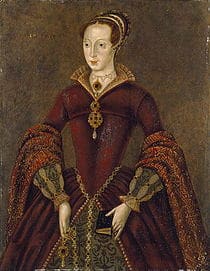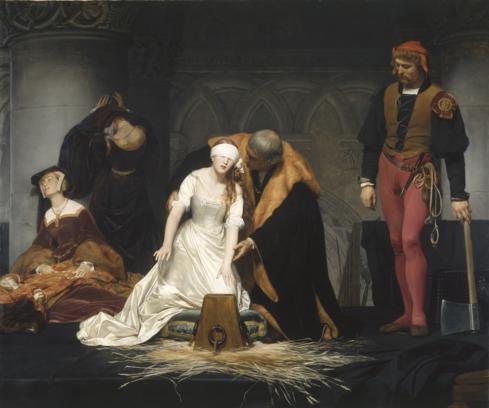
As Guildford Dudley’s body was brought back from Tower Hill, his wife Lady Jane Grey waited with the Lieutenant of the Tower, Sir John Brydges, his brother and deputy – Thomas Brydges, her two ladies and John Feckenham, Mary I’s chaplain and confessor, who had been sent to Jane to prepare her for her death.
According to Eric Ives, Sir John had arranged for Jane to give her prayer book to Thomas, his brother, to then be taken to her father, the Duke of Suffolk, but first asked her to write something in it. Jane obliged and wrote:-
“Forasmuch as you have desired so simple a woman to write in so worthy a book, good Master Lieutenant, therefore I shall as a friend desire you, and as a Christian require you, to call upon God to incline your heart to his laws, to quicken you in his way, and not to take the word of truth utterly out of your mouth.
Live still to die, that by death you may purchase eternal life, and remember how the end of Methuselah, who, as we read in the scriptures, was the longest liver that was of a man, died at the last: for as the Preacher [Ecclesiastes] says, there is a time to be born and a time to die; and the day of death is better than the day of our birth.
Yours, as the Lord knows, as a friend, Jane Dudley”
Lady Jane Grey was then led out by the Lieutenant, followed by the others, to a scaffold in Tower Green, where she was to have a private execution, unlike her husband who had been executed on Tower Hill. Ives writes that Jane’s ladies wept as they walked but Jane controlled her emotions. He describes her as:-
“Dressed as for her trial, all in black, she carried her prayer book which she read from all the way”.
Ives also makes the rather sad comment that “Jane’s death was little more than an exercise in refuse disposal” and that it is not likely that she had as many spectators as someone like Anne Boleyn. How awful that Jane’s short life made such little impact.
He then goes on to describe her execution in detail. As she climbed the scaffold, Jane askedThomas Brydges if she was allowed to speak her mind, he agreed and she made the following speech:-
“Good people, I am come hither to die, and by a law I am condemned to the same; the fact indeed against the Queen’s Highness was unlawful and the consenting thereunto by me: but touching the procurement and desire thereof by me or on my behalf, I do wash my hands thereof in innocency before the face of God and the face of you good Christian people this day.
I pray you all good Christian people to bear me witness that I die a true Christian woman and that I do look to be saved by no other mean, but only by the mercy of God, in the merits of the blood of his only son Jesus Christ. I confess when I did know the word of God I neglected the same and loved myself and the world, and therefore this plague or punishment is happily and worthily [deservedly] happened unto me for my sins. I thank God of his goodness that he has given me a time and respite to repent.
Now good people, I pray you to assist me with your prayers. Now good people, while I am alive, I pray you to assist me with your prayers.”
In this speech we can see that, at first, Jane was following the usual convention of conceding that her sentence was legal but she then goes on to talk of her innocence. She then talks of how she believes in salvation by faith alone (the Protestant belief), that she deserves her death, for her sins, and then finishes by asking for prayers; however, she makes it clear that she does not need prayer for her soul after her death because she believes that she is already saved. “To the last Jane was determined to witness to the truth – and in Greek, her beloved Greek, the word for witness was martyr” Eric Ives.
After her speech, Jane then knelt and said Psalm 51, the Misere, in English “in a most devout manner to the end”:-
“Have mercy upon me O God, after they great goodness: according to the multitude of thy mercies, do away mine offences.”
Jane then thanked her companions, embraced Feckenham saying “Go and may God satisfy every wish of yours” and then prepared herself for her execution by removing her gloves and handkerchief, handing her prayer book to Thomas Brydges, removing her gown, headdress and collar, and then forgiving the executioner who knelt before her.
When the executioner asked her to move onto the straw and she saw the block, Jane asked “I pray you, despatch me quickly” and then when she knelt before the block “Will you take it off before I lay me down?”. “No, madam” was the answer and we can only imagine how the executioner felt as he saw this teenage girl before him. Ives then writes that Jane tossed her head forward, out of the way of her neck, and put on the blindfold. It was then that she panicked: “What shall I do? Where is it?” as she searched frantically for the block. Seeing her panic and seeing that her companions were helpless, a bystander had to approach Jane and guide her to the block. She then put her neck on the block and said “Lord, into thy hands I commend my spirit” and head was taken off with one blow of the axe.

Ives writes that after her death “the shock drained the Tower of all resolution. Hours later Jane’s headless body still lay on the scaffold in a welter of blood.” It seems that people were shocked by the bloody end of this innocent young life.
I’m going to end this article with Eric Ives’s poignant conclusion from his final chapter “Envoi”, I can’t do any better!
“The pages of history are asterisked with names which defy the erosion of time. Jane Grey is one such, but strangely so. Truth to tell she counted for little. She was important for barely nine months, she ruled for only thirteen days. She contributed little to writing and nothing to ideas. She founded no dynasty and left almost no memorabilia. Then what is it, keeps the story of Jane alive while many more significant figures in history are recalled only by scholars? For many years Jane was a saint in the Protestant pantheon, but martyrs are now out of fashion – and so too ideal Victorian maidens. In the West, growing secularization ensures that relatively few people even understand the issues which meant so much to her. And yet her name still lives. Something is due to a memorable sobriquet: “the nine days queen” – not any Jane, that Jane. Romance, too, is part of the explanation; along with Anne Boleyn, Katherine Howard and Mary Queen of Scots, Jane completes a quartet of Tudor queens who died on the scaffold. Undeniable, too, there is the macabre attraction of the girl sacrifice. She died Jane Dudley, but is universally remembered as Jane Grey, Ariadne chained to the rock. All this and more. But the fundamental justification for remembering Jane is the justification for remembering Anne Frank centuries later. They speak for the multitude of brutality’s victims who have no voice.”
Ives then finishes with Jane’s own words:-
“If my faults deserve punishment, my youth at least, and my imprudence were worthy of excuse; God and posterity will show me favour.”
Sources
- “Lady Jane Grey: A Tudor Mystery” by Eric Ives – The Anne Boleyn Files Book of the Month for February
Recommended Reading
There are two books I would highly recommend you read to get a balanced view of Lady Jane Grey and the events that led to her execution in 1554 – “Lady Jane Grey: A Tudor Mystery” by Eric Ives and “The Sisters Who Would Be Queen” by Leanda de Lisle. Leanda and Eric are both respected historians who have meticulously researched the Greys and they both have different views on Jane and also on her family. Both books are great reads.
If you want to read my reviews of both these books then click the links below:-
Lady Jane Grey Exhibition
See Paul Delaroche’s painting “The Execution of Lady Jane Grey” with your own eyes at the National Gallery’s Lady Jane Grey exhibition – click here for details.